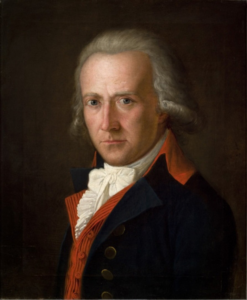Funeral wreath for a child
(Poet's title: Totenkranz für ein Kind)
Set by Schubert:
D 275
[August 25, 1815]
Sanft wehn, im Hauch der Abendluft,
Die Frühlingshalm’ auf deiner Gruft,
Wo Sehnsuchtstränen fallen.
Nie soll, bis uns der Tod befreit,
Die Wolke der Vergessenheit
Dein holdes Bild umwallen.
Wohl dir, obgleich entknospet kaum,
Von Erdenlust und Sinnentraum,
Von Schmerz und Wahn geschieden.
Du schläfst in Ruh, wir wanken, irr
Und unstet, bang im Weltgewirr
Und haben selten Frieden!
In the breath of the evening breeze they are swaying gently
On your grave – those spring blades of grass –
Where the tears of longing fall.
Never, until we are liberated by death, shall
The clouds of forgetting
Swirl around your beauteous image!
It is as well for you, although you had only just burst from the bud,
For you there are no earthly delights or dreams of pleasure,
You are cut off from pain and madness.
You are asleep and at rest; we are swaying around aimlessly,
Fearful and unsteady in the confusion of the world,
And we rarely have peace.
All translations into English that appear on this website, unless otherwise stated, are by Malcolm Wren. You are free to use them on condition that you acknowledge Malcolm Wren as the translator and schubertsong.uk as the source. Unless otherwise stated, the comments and essays that appear after the texts and translations are by Malcolm Wren and are © Copyright.
☙
Themes and images in this text:
Breath and breathing Buds Clouds Detours and delusions Dreams Evening and the setting sun Grass Graves and burials Longing and yearning Madness Pictures and paintings Rest Sleep Spring (season) Swaying and swinging Tears and crying Wind Wreaths and garlands
Although it is spring and there are fresh shoots growing above the child’s grave, the mood is gloomy. The spring does not signify any sort of rebirth or resurrection. What we have above ground, where life goes on, is movement and uncertainty (symbolised in the swaying shoots on the grave). The people that survive are also swaying around, disoriented and buffetted by the world’s confusion. Only under the ground, where the child lies ‘asleep’, is there any rest or true peace.
Although the text is called ‘Funeral wreath for a child’ there are no flowers. The child had burst from the bud but is now wilted, as have the flowers placed in or on the grave at the time of the burial. It is only the words of the poem that constitute any sort of garland.
☙
Original Spelling Totenkranz für ein Kind Sanft wehn, im Hauch der Abendluft, Die Frühlingshalm' auf deiner Gruft, Wo Sehnsuchtsthränen fallen. Nie soll, bis uns der Tod befreit, Die Wolke der Vergessenheit Dein holdes Bild umwallen. Wohl dir, obgleich entknospet kaum, Von Erdenlust und Sinnentraum, Von Schmerz und Wahn geschieden! Du schläfst in Ruh´; wir wanken irr Und unstät, bang im Weltgewirr Und haben selten Frieden.
Confirmed by Peter Rastl with Friedrich Matthisson’s Gedichte, Dritte vermehrte Auflage, Zürich, 1794, bey Orell, Gessner, Füssli & Comp., page 128; with Gedichte von Friedrich von Matthisson. Erster Theil. Tübingen, bei Cotta, 1811, page 248; and with Musen-Almanach für 1794, herausgegeben von Joh. Heinr. Voß, Hamburg, bey C.E.Bohn, page 43.
To see an early edition of the text, go to page 43 [79 von 256] here: http://digital.onb.ac.at/OnbViewer/viewer.faces?doc=ABO_%2BZ178663905


